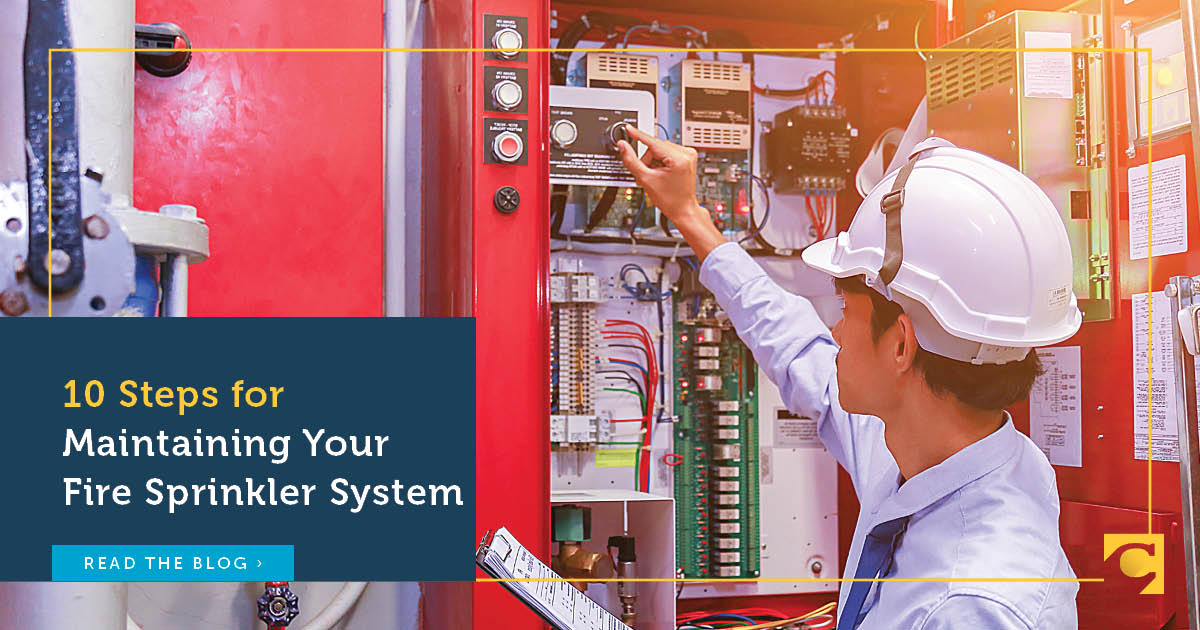10 Steps for Maintaining Your Fire Sprinkler System

One of the best investments you can make in your commercial building is the installation of a fire sprinkler system. A properly designed sprinkler system can greatly reduce your exposure to loss of property and lives from fires.
That same system can also reduce your property insurance costs. However, installing the sprinkler system is just the beginning. Just like specialized machinery used in a manufacturing process, sprinkler systems need regular inspection, maintenance, and testing in order to function at their full potential.
To help ensure your sprinkler system performs properly in the event of a fire, these basic maintenance and inspection requirements should be followed:
10 Steps For Maintaining Your Fire Sprinkler System
Test Every 5 Years
1. Complete an internal pipe exam every five years. The purpose of this test is to inspect for the presence of foreign materials that might obstruct the flow of water from through the pipes to the sprinklers. Follow the full inspection process here.
2. Test or replace pressure gauges in comparison with a calibrated gauge. Those deemed not to be accurate within the standard scale reading must be recalibrated or replaced. (Explore these scales and requirements here.)
Test Every Year
3. Complete an annual flow test. This includes testing to ensure water flow detecting devices are operational, and that a signal is properly triggered when you allow the water to flow for 60 seconds. Follow the full testing process here.
4. Visually inspect piping on an annual basis to ensure the system is in operating condition and free of physical damage.
5. Perform an annual visual inspection of the fire department connection to be sure the caps have not been removed. If the caps have been removed, debris or insects may build nests in the connection, resulting in obstructions in the system during sprinkler head operations.
6. Visually inspect sprinkler heads annually. Heads over 50 years old (especially those manufactured before 1920) should be replaced or a representative sample of heads should be sent to a recognized laboratory for testing. If one head were to fail testing, all heads in the representative area should be replaced. Testing is then required every ten years.
Test Every Quarter
7. Test alarms quarterly. To do this, communicate with your local fire department or central station and warn them you will be testing these systems. Then trigger activation of alarms through the running of water through the inspector test valve, and confirm whether or not the alarm sounds.
Test Every Week
8. Visually inspect the control valves on a weekly basis. This includes ensuring that the valves are open and secured, and confirming there are no visible leaks in the equipment.
9. Ensure all storage is at least 18-inches below sprinkler heads in order to prevent interference with the spray of water from a sprinkler head during a fire.
Check As Often As Desired
10. Reference the full and comprehensive list of testing and maintenance requirements from the NFPA 25 to ensure your system is up-to-date.
Keep In Mind
All testing should be performed by qualified personnel, preferably a licensed and insured sprinkler fire protection contractor. Always keep sprinkler design and testing paperwork onsite to allow easy access for contractors, insurance carrier loss control representatives, and insurance property rate promulgation companies such as Verisk.
The Central Difference
Central Insurance was first founded as a fire insurance company in 1876 and, as such, has an ongoing vested interest in fire safety. Our loss control consultants are trained to evaluate the basic adequacy of sprinkler systems, and are happy to address any concerns as part of the general survey process for Commercial Property Insurance policyholders.
Not already covered by Central? Find an independent Central agent today to get a quote.
Like this:
Loading…







